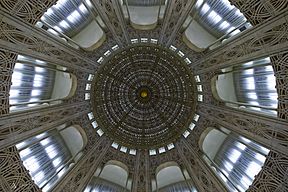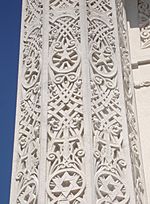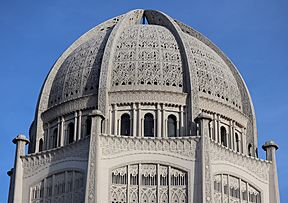Baháʼí House of Worship (Wilmette, Illinois) facts for kids
Quick facts for kids |
|
|
Baháʼí House of Worship (Wilmette, Illinois)
|
|
 |
|
| Location | 100 Linden Ave., Wilmette, Illinois |
|---|---|
| Area | 6.97 acres (2.82 ha) |
| Built | 1912-1953 |
| Architect | Louis Bourgeois George A. Fuller |
| NRHP reference No. | 78001140 |
| Added to NRHP | May 23, 1978 |
The Baháʼí House of Worship in Wilmette, Illinois is a special temple for the Baháʼí Faith religion. It's located in Wilmette, Illinois, a town near Chicago. This temple was the second Baháʼí House of Worship ever built, and it's the oldest one still standing today. It's one of only eight such temples around the world, built to serve all of North America.
A French-Canadian architect named Louis Bourgeois designed the temple. He got ideas and advice from ʻAbdu'l-Bahá, who was the leader of the Baháʼí Faith at the time. To show the Baháʼí idea of "unity of religion" (meaning all religions are connected), Bourgeois included designs and symbols from many different faiths in the building. Even though a special groundbreaking ceremony happened in 1912, with a cornerstone laid, the main construction didn't really start until the early 1920s. Building was slow because of big events like the Great Depression and World War II. Work picked up again in 1947, and the temple was officially opened in 1953.
Baháʼí Houses of Worship are meant to be more than just temples. They are planned to have other buildings around them, like schools or places to help people. However, this hasn't happened yet for most of them. These temples are not for local meetings but are open to everyone, no matter their faith. They are peaceful places for prayer and thinking.
Contents
How the Temple Was Built
The First Ideas
The idea for a Baháʼí House of Worship in the Chicago area started in 1903. At that time, the very first Baháʼí temple was being built far away in Turkmenistan. A Baháʼí woman from Chicago named Corinne Knight True was very involved in this idea. In 1907, she traveled to visit ʻAbdu'l-Bahá, the leader of the Baháʼí Faith. She told him about the growing interest in building a temple in the United States.
ʻAbdu'l-Bahá liked the idea. He suggested building the temple away from the busy city of Chicago, in a quieter spot near Lake Michigan. The Baháʼís thought about building it in Chicago's Jackson Park or in the nearby town of Evanston. But they finally chose Wilmette, Illinois, which is just north of Evanston. Corinne True became very important in leading this project and raising money. People later called her "the mother of the Temple."
People from all over the world helped raise money for the temple. For example, Baháʼís in France sent money even after a big flood in Paris. A woman from Chicago named Nettie Tobin didn't have money to give, so she donated a piece of limestone she found. This stone became the special cornerstone of the building. ʻAbdu'l-Bahá himself came to Wilmette in 1912 to place this stone during his travels to the West. The actual building work didn't start until the 1920s, after everyone agreed on Louis Bourgeois's design. His design mixed many different styles of architecture.
Building the Temple
By 1922, the first part of the building, called the Foundation Hall, was almost done. Baháʼís started using it for meetings. But then, building slowed down because money became scarce. Also, some people in Wilmette were not happy about the construction site. Strange stories started going around! Some thought the building was used to keep a live white whale. Others even believed it was a secret place to refuel captured German submarines in the Great Lakes!
Luckily, more money came in from Baháʼís, and construction started again. In 1930, a company was hired to build the main frame of the building, called the superstructure. This part was finished in 1931. A year later, work began on the outside covering of the building, made of concrete.
A small model of the temple was shown at Chicago's 1933–34 World's Fair, called the "Century of Progress Exposition." People started traveling to Wilmette to see the real building take shape. The outside of the temple was finished in January 1943.
After the outside was done, work was still needed on the inside and the gardens. Louis Bourgeois, the architect, had died in 1930 before he could finish all his plans for the inside. So, in 1947, another architect named Alfred Shaw was hired to design the interior details. During World War II, the US Navy even used the temple as a landmark for training fighter pilots! A plan for the beautiful gardens around the building was approved in 1951.
Opening and Its Importance
The Baháʼí House of Worship was finally opened on May 2, 1953. Over 3,500 people came to the ceremony, including 91-year-old Corinne True, who had worked so hard for it. Rúhíyyih Khanum, the wife of Shoghi Effendi (who led the religion after ʻAbdu'l-Bahá), read a special prayer. Important people like Supreme Court Justice William O. Douglas also sent messages of praise.
In 1978, the House of Worship was added to the National Register of Historic Places. This means it's recognized as an important historical site. The building has become a very popular place for tourists to visit. The Illinois Office of Tourism even calls it one of the "Seven Wonders of Illinois." In 2019, a photo of the Wilmette Baháʼí House of Worship was one of the top 15 winners in an international photo contest called Wiki Loves Monuments.
What Makes the Temple Special?
The House of Worship has a large dome and is surrounded by beautiful gardens and fountains. It sits on a piece of land about 7 acres big. The inside of the dome is very tall, reaching 138 feet (about 42 meters) high. The main room, where people sit, can hold 1,191 people.
The number nine is very important in the Baháʼí Faith. It's the last number in our number system, and Baháʼís believe it stands for perfection and completion. Also, the word Bahá (which means "glory" in Arabic) has a value of nine in an old number system. Because of this, many parts of the temple are designed in groups of nine. For example, there are nine entrances, nine sections in the dome, and nine fountains in the gardens.
The outside of the building is covered with a special concrete mix. Many detailed designs are carved into this concrete. You can find writings from Baháʼu'lláh, the founder of the Baháʼí Faith, above the entrances and inside the building. The pillars on the outside have symbols from many different religions, like the Christian cross, the Star of David, and the Crescent and star. They also have a symbol used by Hindus and Buddhists (a swastika). At the top of each pillar, there's a nine-pointed star, which is a symbol of the Baháʼí Faith.
If you look up at the center of the dome ceiling, you'll see an Arabic writing. This is a Baháʼí symbol called the "Greatest Name." It means "O Thou Glory of Glories." It reminds Baháʼís that Baháʼu'lláh is considered the greatest messenger of God.
The architect, Louis Bourgeois, used to have his design studio right across the street from the temple.
Images for kids
See also
 In Spanish: Casa de Adoración bahaí (Illinois) para niños
In Spanish: Casa de Adoración bahaí (Illinois) para niños









